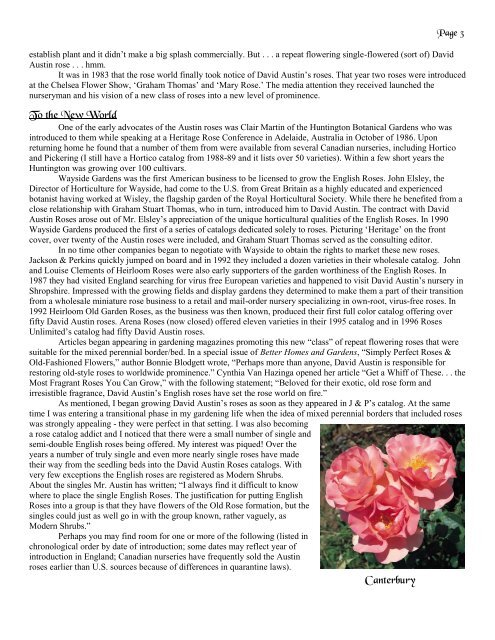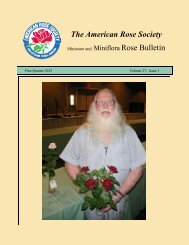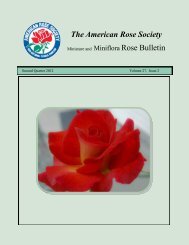Volume 6 in PDF Format - Paul Zimmerman Roses
Volume 6 in PDF Format - Paul Zimmerman Roses
Volume 6 in PDF Format - Paul Zimmerman Roses
You also want an ePaper? Increase the reach of your titles
YUMPU automatically turns print PDFs into web optimized ePapers that Google loves.
Page 3<br />
establish plant and it didn’t make a big splash commercially. But . . . a repeat flower<strong>in</strong>g s<strong>in</strong>gle-flowered (sort of) David<br />
Aust<strong>in</strong> rose . . . hmm.<br />
It was <strong>in</strong> 1983 that the rose world f<strong>in</strong>ally took notice of David Aust<strong>in</strong>’s roses. That year two roses were <strong>in</strong>troduced<br />
at the Chelsea Flower Show, ‘Graham Thomas’ and ‘Mary Rose.’ The media attention they received launched the<br />
nurseryman and his vision of a new class of roses <strong>in</strong>to a new level of prom<strong>in</strong>ence.<br />
To the New World<br />
One of the early advocates of the Aust<strong>in</strong> roses was Clair Mart<strong>in</strong> of the Hunt<strong>in</strong>gton Botanical Gardens who was<br />
<strong>in</strong>troduced to them while speak<strong>in</strong>g at a Heritage Rose Conference <strong>in</strong> Adelaide, Australia <strong>in</strong> October of 1986. Upon<br />
return<strong>in</strong>g home he found that a number of them from were available from several Canadian nurseries, <strong>in</strong>clud<strong>in</strong>g Hortico<br />
and Picker<strong>in</strong>g (I still have a Hortico catalog from 1988-89 and it lists over 50 varieties). With<strong>in</strong> a few short years the<br />
Hunt<strong>in</strong>gton was grow<strong>in</strong>g over 100 cultivars.<br />
Wayside Gardens was the first American bus<strong>in</strong>ess to be licensed to grow the English <strong>Roses</strong>. John Elsley, the<br />
Director of Horticulture for Wayside, had come to the U.S. from Great Brita<strong>in</strong> as a highly educated and experienced<br />
botanist hav<strong>in</strong>g worked at Wisley, the flagship garden of the Royal Horticultural Society. While there he benefited from a<br />
close relationship with Graham Stuart Thomas, who <strong>in</strong> turn, <strong>in</strong>troduced him to David Aust<strong>in</strong>. The contract with David<br />
Aust<strong>in</strong> <strong>Roses</strong> arose out of Mr. Elsley’s appreciation of the unique horticultural qualities of the English <strong>Roses</strong>. In 1990<br />
Wayside Gardens produced the first of a series of catalogs dedicated solely to roses. Pictur<strong>in</strong>g ‘Heritage’ on the front<br />
cover, over twenty of the Aust<strong>in</strong> roses were <strong>in</strong>cluded, and Graham Stuart Thomas served as the consult<strong>in</strong>g editor.<br />
In no time other companies began to negotiate with Wayside to obta<strong>in</strong> the rights to market these new roses.<br />
Jackson & Perk<strong>in</strong>s quickly jumped on board and <strong>in</strong> 1992 they <strong>in</strong>cluded a dozen varieties <strong>in</strong> their wholesale catalog. John<br />
and Louise Clements of Heirloom <strong>Roses</strong> were also early supporters of the garden worth<strong>in</strong>ess of the English <strong>Roses</strong>. In<br />
1987 they had visited England search<strong>in</strong>g for virus free European varieties and happened to visit David Aust<strong>in</strong>’s nursery <strong>in</strong><br />
Shropshire. Impressed with the grow<strong>in</strong>g fields and display gardens they determ<strong>in</strong>ed to make them a part of their transition<br />
from a wholesale m<strong>in</strong>iature rose bus<strong>in</strong>ess to a retail and mail-order nursery specializ<strong>in</strong>g <strong>in</strong> own-root, virus-free roses. In<br />
1992 Heirloom Old Garden <strong>Roses</strong>, as the bus<strong>in</strong>ess was then known, produced their first full color catalog offer<strong>in</strong>g over<br />
fifty David Aust<strong>in</strong> roses. Arena <strong>Roses</strong> (now closed) offered eleven varieties <strong>in</strong> their 1995 catalog and <strong>in</strong> 1996 <strong>Roses</strong><br />
Unlimited’s catalog had fifty David Aust<strong>in</strong> roses.<br />
Articles began appear<strong>in</strong>g <strong>in</strong> garden<strong>in</strong>g magaz<strong>in</strong>es promot<strong>in</strong>g this new “class” of repeat flower<strong>in</strong>g roses that were<br />
suitable for the mixed perennial border/bed. In a special issue of Better Homes and Gardens, “Simply Perfect <strong>Roses</strong> &<br />
Old-Fashioned Flowers,” author Bonnie Blodgett wrote, “Perhaps more than anyone, David Aust<strong>in</strong> is responsible for<br />
restor<strong>in</strong>g old-style roses to worldwide prom<strong>in</strong>ence.” Cynthia Van Haz<strong>in</strong>ga opened her article “Get a Whiff of These. . . the<br />
Most Fragrant <strong>Roses</strong> You Can Grow,” with the follow<strong>in</strong>g statement; “Beloved for their exotic, old rose form and<br />
irresistible fragrance, David Aust<strong>in</strong>’s English roses have set the rose world on fire.”<br />
As mentioned, I began grow<strong>in</strong>g David Aust<strong>in</strong>’s roses as soon as they appeared <strong>in</strong> J & P’s catalog. At the same<br />
time I was enter<strong>in</strong>g a transitional phase <strong>in</strong> my garden<strong>in</strong>g life when the idea of mixed perennial borders that <strong>in</strong>cluded roses<br />
was strongly appeal<strong>in</strong>g - they were perfect <strong>in</strong> that sett<strong>in</strong>g. I was also becom<strong>in</strong>g<br />
a rose catalog addict and I noticed that there were a small number of s<strong>in</strong>gle and<br />
semi-double English roses be<strong>in</strong>g offered. My <strong>in</strong>terest was piqued! Over the<br />
years a number of truly s<strong>in</strong>gle and even more nearly s<strong>in</strong>gle roses have made<br />
their way from the seedl<strong>in</strong>g beds <strong>in</strong>to the David Aust<strong>in</strong> <strong>Roses</strong> catalogs. With<br />
very few exceptions the English roses are registered as Modern Shrubs.<br />
About the s<strong>in</strong>gles Mr. Aust<strong>in</strong> has written; “I always f<strong>in</strong>d it difficult to know<br />
where to place the s<strong>in</strong>gle English <strong>Roses</strong>. The justification for putt<strong>in</strong>g English<br />
<strong>Roses</strong> <strong>in</strong>to a group is that they have flowers of the Old Rose formation, but the<br />
s<strong>in</strong>gles could just as well go <strong>in</strong> with the group known, rather vaguely, as<br />
Modern Shrubs.”<br />
Perhaps you may f<strong>in</strong>d room for one or more of the follow<strong>in</strong>g (listed <strong>in</strong><br />
chronological order by date of <strong>in</strong>troduction; some dates may reflect year of<br />
<strong>in</strong>troduction <strong>in</strong> England; Canadian nurseries have frequently sold the Aust<strong>in</strong><br />
roses earlier than U.S. sources because of differences <strong>in</strong> quarant<strong>in</strong>e laws).<br />
Canterbury





